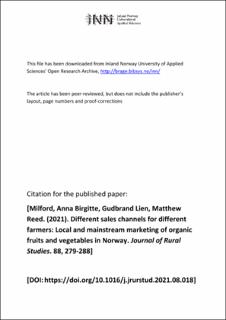| dc.contributor.author | Milford, Anna Birgitte | |
| dc.contributor.author | Lien, Gudbrand | |
| dc.contributor.author | Reed, Matthew | |
| dc.date.accessioned | 2023-08-30T13:11:59Z | |
| dc.date.available | 2023-08-30T13:11:59Z | |
| dc.date.created | 2021-09-17T15:50:09Z | |
| dc.date.issued | 2021 | |
| dc.identifier.citation | Journal of Rural Studies. 2021, 88, 279-288. | en_US |
| dc.identifier.issn | 0743-0167 | |
| dc.identifier.uri | https://hdl.handle.net/11250/3086403 | |
| dc.description | © 2021 Elsevier Ltd. All rights reserved. This is the postprint version of the article published in Journal of Rural Studies. It will be available 18.08.2023 after an embargo period of 24 months.You can find the published article here: https://doi.org/10.1016/j.jrurstud.2021.08.018 | en_US |
| dc.description.abstract | Most food in developed countries, including organic fruits and vegetables, is sold through supply chains run by large wholesalers and supermarket chains. A certain share is sold through local marketing channels such as speciality stores, food box schemes, farmers' markets, and community-supported agriculture (CSA). This study uses qualitative interviews and a quantitative survey to expose the differences between mainstream and local marketing of organic fruits and vegetables in Norway, why and to what extent farmers selling through these two sales channels are different. We find that the supermarket chains' requirements to provide large quantities of uniform product are burdensome for smaller farmers to match. Farmers supplying the mainstream supermarkets tend to be larger and more rurally located. Farmers selling through local marketing are likely to be smaller, closer to urban areas and more diversified in their production. For local marketing farmers, it is more feasible to produce according to organic principles, using local resources and crop rotation. Survey results also show that local marketing farmers are less motivated to produce fruits and vegetables by income and more motivated to produce organically to achieve better quality and sustainability. At the same time, there are also many similarities between the two groups, and we do not find evidence of a general “conventionalisation” of organic agriculture in Norway. | en_US |
| dc.language.iso | eng | en_US |
| dc.subject | marketing | en_US |
| dc.subject | local food | en_US |
| dc.subject | organic fruits and vegetables | en_US |
| dc.subject | Norway | en_US |
| dc.title | Different sales channels for different farmers: Local and mainstream marketing of organic fruits and vegetables in Norway | en_US |
| dc.type | Peer reviewed | en_US |
| dc.type | Journal article | en_US |
| dc.description.version | acceptedVersion | en_US |
| dc.subject.nsi | VDP::Samfunnsvitenskap: 200::Økonomi: 210 | en_US |
| dc.source.pagenumber | 279-288 | en_US |
| dc.source.volume | 88 | en_US |
| dc.source.journal | Journal of Rural Studies | en_US |
| dc.identifier.doi | 10.1016/j.jrurstud.2021.08.018 | |
| dc.identifier.cristin | 1935515 | |
| dc.relation.project | Norges forskningsråd: 294604 | en_US |
| cristin.ispublished | true | |
| cristin.fulltext | postprint | |
| cristin.qualitycode | 2 | |
